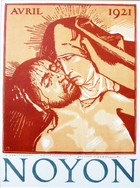Jacques Beltrand
(1874-1977)
The son of an art-maker, born at 1 rue des Artistes in the Montparnasse artist quarter of Paris, Jacques Beltrand was destined for a life in the arts. His father, Tony, taught him at an early age how to make printing blocks, cutting with the grain of panels and across end sections of wood. When Jacques joined his father and three younger brothers, Camille, Georges and Marcel in opening a studio in 1896, he surpassed them in his mastery of woodblock printmaking and played a pivotal role in the 20th century revival of the art of the woodcut in France, promoting the use of water-based inks to create subtle color effects in the style of Japanese prints.
Beltrand was especially gifted in converting images from other art mediums into woodblock prints for book illustrations. His fine eye for details can be seen in the 1935 woodcut, Christ Healing the Paralytic, where he replicates a mid-16th century Italian print, adding his own camaieu color effects. Beltrand favored this wash-like form of ink application and used it on the magenta robes of Christ the King and the royal blue of France’s monarch-saint, Louis IX in the gallery. Beltrand dismissed the notion he was a mere copyist, engaged in “a servile art.” As he explained in a 1938 essay on woodblock art: “While obeying a conception which is foreign to it, it creates anew by new means…obtained by the handling of the chisel.”
The master printmaker in wood formed an especially close relationship with Maurice Denis, a prime mover on the early 20th century French sacred art scene. Beltrand collaborated with Denis in turning his original designs into woodblock illustrations for 23 publications, including The Little Flowers of St. Francis of Assisi (1919) and The Book of Tobias (1929) in the Collection library. His color plates for the latter glow like Denis paintings. Beltrand spent holidays at Denis’ summer home in Brittany and created prints to commemorate family milestones like the birth of Jean-Dominique Denis in 1909 and the child’s First Holy Communion, signed with an affectionate dedication to “Petit Poulet (Chicken Little.)”
Beltrand was a frontline soldier, wounded by a shell in the opening months of World War I. The restoration of sacred sites damaged in the conflict and the preservation of historic churches was a cause close to his heart, He created the cover art of the ruins of the Abbey of St. Jean-des-Vignes in Soissons for the program of an April 1919 fund-raising concert for "devasted churches" and served in the 1920s as president of The Society of Friends of Cathedrals, making prints promoting A.D.C. group activities in various cathedral towns across France like Rouen. A 1925 color woodcut for the A.D.C. of the pensive Christ awaiting the horrors of Golgotha includes a quotation from the Pensees of French Philosopher Blaise Pascal (1).
Beltrand’s sacred imagery breaks no new ground. His works are conservative in style, evoking masterworks from the past. His Madonna in Blue woodcut suggests gothic sculptures at. Reims Cathedral. A Nativity scene pays homage to the graphic works of the 16th century German Artist Martin Schongauer, while another Virgin Mary and Baby Jesus print recalls the luminous Madonnas of Italian Renaissance Master Sandro Botticelli. The blood-stained face of Christ and the grieving Virgin Mary in his Noyon print bring to mind late medieval variations on the Deposition from the Cross like the Tarascon Pieta.
By 1940, Beltrand was a pillar of the art establishment--a professor at the Ecole des Beaux-Arts, President of the Society of Painter Engravers of France, and Officer of the Legion of Honor. He would be one of only a handful of artists officially condemned after World War II for his “collaboration with the enemy” as an appraiser of art objects looted from Jewish collectors during the Nazi occupation. Beltrand was banned from exhibiting or selling his art for two years. In a reversal typical of postwar France, he was one of the first inductees into the new Order of Arts and Letters, established by the De Gaulle government in 1957.
It is a hard to reconcile the Beltrand who deliberately undervalued stolen Vermeers at the bidding of Hermann Goering with the conservator of cathedrals and “the beautiful soul and first rate artist” warmly remembered for his unstinting help to aspiring art-makers in a 1980 tribute by French Artist Michel Ciry. You cannot fault Ciry for his assessment of the printmaker’s level of craftsmanship. As he wrote: “Beltrand succeeded in making blocks of boxwood vibrate…so much so that it is often difficult to admit that we are in front of wood when we look at one of his proofs, so well did he know how to multiply the resources of this rather ungrateful material, suitable in his hands for all types of graphic design.”
(1)Jesus is alone on the earth, without any one not only to feel and share His suffering, but even to know of it; He and Heaven were alone in that knowledge. From Pensees by Blaise Pascal, Section VII (553)
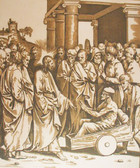
Christ Healing the Paralytic
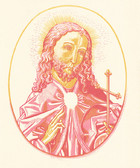
Christ the King
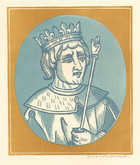
St. Louis
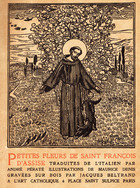
Little Flowers of St. Francis (Cover)
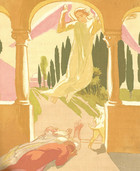
Appearance of the Angel Raphael
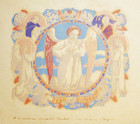
The Birth of Jean-Dominque Denis
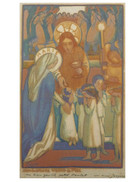
"Let Them Come to Me"

"Devasted Churches" concert program cover
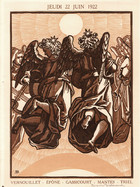
Celestial Music
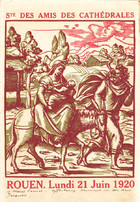
The Flight into Egypt

Pensive Christ

Madonna in Blue
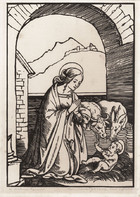
The Nativity
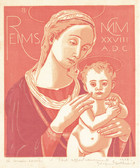
Reims Madonna & Child
